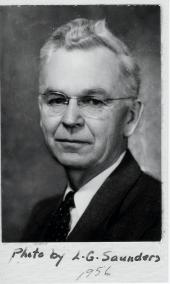
Born in a Mennonite community in Ukraine on June 26, 1903, Rempel and his brothers fled after the destruction of the community during the Russian Revolution in 1919. They came to Langham, Saskatchewan in 1923. Rempel completed high school in Prince Albert and entered the University of Saskatchewan on a scholarship in 1928, where he earned High Honours in Biology in 1931 and an MSc in freshwater biology in 1933. In 1934 he was hired to teach at Regina College, taking leave to earn a PhD in entomology at Cornell University in 1936. He returned to the University of Saskatchewan in 1946. In 1961 he was appointed Rawson Professor, a position he held until his retirement in 1970.
Professor Rempel was an outstanding teacher. In addition to entomology classes he taught biological sciences to thousands of humanities and social sciences students. He also guided the research of many graduate students. He made lasting contributions to science in several research areas, beginning his career with the study of the midge Chironomus hyperboreus in Prince Albert National Park. This led to work on chironomid (fish fly) taxonomy. He then turned to biting flies: first to the ecology and control of blackflies, which adversely affected cattle populations; and then to mosquitoes, which were vectors of the virus causing the western equine sleeping sickness (encephalitis) which occurred as a pandemic in the late 1930s.
He closed off his distinguished research career with classic studies in insect embryology. He studied the development of the bertha army worm, two species of beetle, and the black widow spider. His last major contribution, The Evolution of the Insect Head: The Endless Dispute, was published a year before he died. It clarified an issue that had elicited twelve different theories. Overall, Rempel had contributed more than fifty publications.
He won many honours. He was elected a Fellow of the Royal Society in 1956, and received the Centennial Medal in 1967 “in recognition of valuable service to the Nation.”
In 1971 he received the Gold Medal of the Entomological Society of Canada. He was president of the Entomological Society of Saskatchewan and of the International Conference on Diseases of Nature Communicable to Man. He also served for ten years as associate editor of the Canadian Journal of Zoology, and for a similar period on the Advisory Panel on Entomology of the Defence Research Board of Canada.
During his freshwater biology studies he married Greta Halliday, and they had three children. After his retirement, he moved to Victoria, but remained active in research until just before his death on May 30, 1976.
U. Theodore Hammer